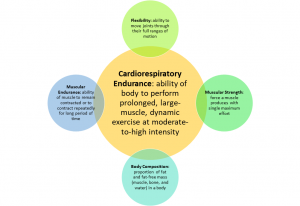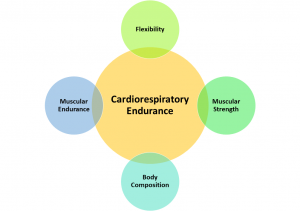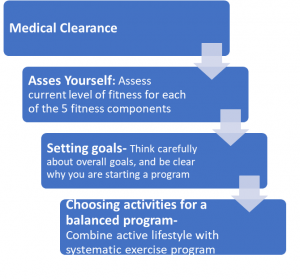2 Basics of Fitness Program Design
Module Overview
In this module, you will learn about the different components of physical fitness. You will also begin to learn about the principals involved in designing an exercise program.
Module Objectives
1. Describe the components of physical fitness
2. Define the FITT principle
3. Define the principles of physical fitness
Physical Activity vs. Exercise

Physical Activity Guidelines
- The American College of Sports Medicine (ACSM) recommends 30 minutes of moderate-intensity physical activity on 5 or more days per week or 20 minutes of vigorous-intensity activity 3 or more days per week
- (Citation: Riebe, Deborah; Ehrman, Jonathan K; Liguori, Gary; Magal, Meir. ACSM’s Guidelines for Exercise Testing and Prescription 10th Edition.)
- Dose-Response Relationship: Increasing volume and intensity results in additional health benefits
- Increasing physical activity to improve health and wellness
Moderate vs. Vigorous Intensity

Citation: https://www.cdc.gov/physicalactivity/basics/measuring/index.html
College Student Physical Activity Behaviors

- Citation: American College Health Association. American College Health Association-National College Health Assessment III: Reference Group Executive Summary Fall 2020. Silver Spring, MD: American College Health Association; 2020.
- https://www.acha.org/documents/ncha/NCHA-III_Fall_2020_Reference_Group_Executive_Summary.pdf
Physical Activity & Exercise Recommendations Based on Goals



- Citation: Garber. C. E. et at 2011. Quantity and quality of exercise for developing and maintaining cardiorespiratory, musculoskeletal, and neuramotor fitness in apparently healthy adults: Guidance for prescribing exercise. Medicine and Science in Sports and Exercise 43(7). 1334-1359. Physical Activity Guidelines Advisory Committee. 2008. Physical Activity Guidelines Advisory Committee Report, 2008. Washington. DC.: U.S. Department of Health and Human Services; U.S. Department of Hearth and Human Services. 2010. The Surgeon Generals Vision for a Healthy and Fit Nation. Rockville. Md.: US. Department of Health and Human Services. Office of the Surgeon General.
Fitness
- Health-related fitness: physical capacities that contribute to health
- Skill-related fitness: complex control of muscles and movement by brain and spinal column
Components of Fitness

Examples of Components of Fitness

Skill-Related Components of Fitness
- Speed
- Power
- Agility
- Balance
- Coordination
- Reaction
- Movement Time
Principles of Physical Training
- Adaptation: physiological changes that occur with exercise training
- Human body adaptable, adjusting to meet increasing demands
- Short-term adjustments lead to long-term changes and improvements in fitness levels.
- Specificity: to develop a particular fitness component, one must perform exercises designed specifically for that component
- Well-rounded exercise program should include exercises geared to each component of fitness
- Progressive Overload: placing increasing amounts of stress on the body causes adaptations that improve fitness
- As amount of exercise progressively increases, fitness improves
- Reversibility: fitness improvements are lost when demands on the body are lowered
- If a person stops exercising, 50% of fitness improvements are lost within 2 months
- Individual Differences: there are large differences in our ability to improve fitness and perform skills
- Specific genes influence body fat, strength, and endurance


- Citation:ACSM https://www.exerciseismedicine.org/assets/page_documents/EIM_Rx%20for%20Health_Being%20Active%20for%20a%20Better%20Life.pdf
FITT Principle
- Frequency: How many days per week
- Intensity: Low/moderate/vigorous
- Time: Duration of exercise
- Type: Mode of activity (what type of exercise)
Designing Your Own Fitness Program

Guidelines for Training
- Train the way you want to shape your body to change
- Train regularly
- Start slowly and progress gradually
- Increase duration and frequency before increasing intensity
- Warm-up before exercise and cool-down after exercise
- Exercise safely – overloading your muscles and joints can lead to serious injury, so train within your capacity
- Listen to your body and get adequate rest
- Cycle the volume and intensity of your workouts
- Vary your activities and train with a partner in order to prevent boredom
- Fuel your activity appropriately
- Track your progress
- Get advise if you need it
- Have fun!
Sedentary Behavior
- In addition to your fitness program you should also avoid regular sedentary behavior

- Citation: World Health Organization. WHO Guidelines on Physical Activity and Sedentary Behaviour. s.n.; 2020.
- https://www.who.int/publications/i/item/9789240015128
References
- American College Health Association. American College Health Association-National College Health Assessment III: Reference Group Executive Summary Fall 2020. Silver Spring, MD: American College Health Association; 2020.) https://www.acha.org/documents/ncha/NCHA-III_Fall_2020_Reference_Group_Executive_Summary.pdf
- https://www.cdc.gov/physicalactivity/basics/measuring/index.html
- Garber. C. E. et at 2011. Quantity and quality of exercise for developing and maintaining cardiorespiratory, musculoskeletal, and neuramotor fitness in apparently healthy adults: Guidance for prescribing exercise. Medicine and Science in Sports and Exercise 43(7). 1334-1359. Physical Activity Guidelines Advisory Committee. 2008. Physical Activity Guidelines Advisory Committee Report, 2008. Washington. DC.: U.S. Department of Health and Human Services; U.S. Department of Hearth and Human Services. 2010. The Surgeon Generals Vision for a Healthy and Fit Nation. Rockville. Md.: US. Department of Health and Human Services. Office of the Surgeon General. https://www.exerciseismedicine.org/assets/page_documents/EIM_Rx%20for%20Health_Being%20Active%20for%20a%20Better%20Life.pdf
- Riebe, Deborah; Ehrman, Jonathan K; Liguori, Gary; Magal, Meir. ACSM’s Guidelines for Exercise Testing and Prescription 10th Edition.
- World Health Organization. WHO Guidelines on Physical Activity and Sedentary Behaviour. s.n.; 2020. https://www.who.int/publications/i/item/9789240015128
Media Attributions
- cardio
- components
- starting

